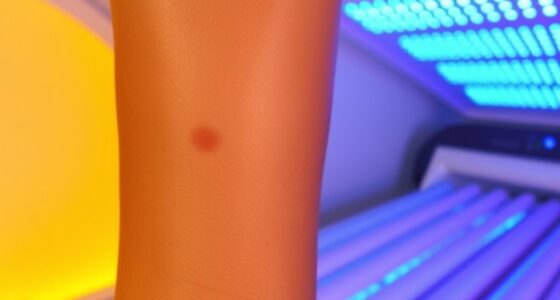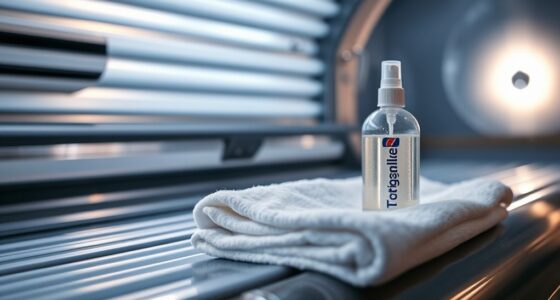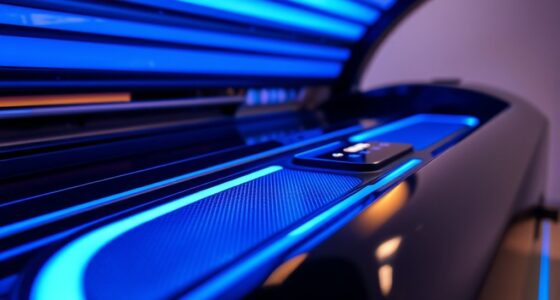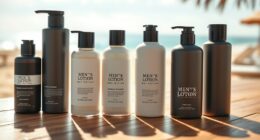To keep your tanning bed in top shape, you should perform daily and weekly cleaning of vents, acrylic shields, and contact surfaces. Regularly inspect lamps and starters, replacing any flickering or faulty components, and clean bulbs with proper cleaners. Keep acrylic shields free of damage and make sure filters are clean and functioning. Conduct safety checks on doors, electrical systems, and vents, and stick to scheduled maintenance to prevent breakdowns. Continuing with proper upkeep will help maximize performance and safety—discover more ways to optimize your bed’s operation.
Key Takeaways
- Regularly inspect and replace lamps to ensure optimal UV output and prevent uneven tanning.
- Clean acrylic shields weekly with approved cleaners to maintain clarity and UV transmission.
- Check and clean vents and internal components weekly to prevent dust buildup and overheating.
- Conduct monthly deep cleaning and safety inspections of electrical connections and structural parts.
- Document all maintenance activities and adhere to manufacturer guidelines for safe, effective operation.
Regular Cleaning and Disinfection Practices
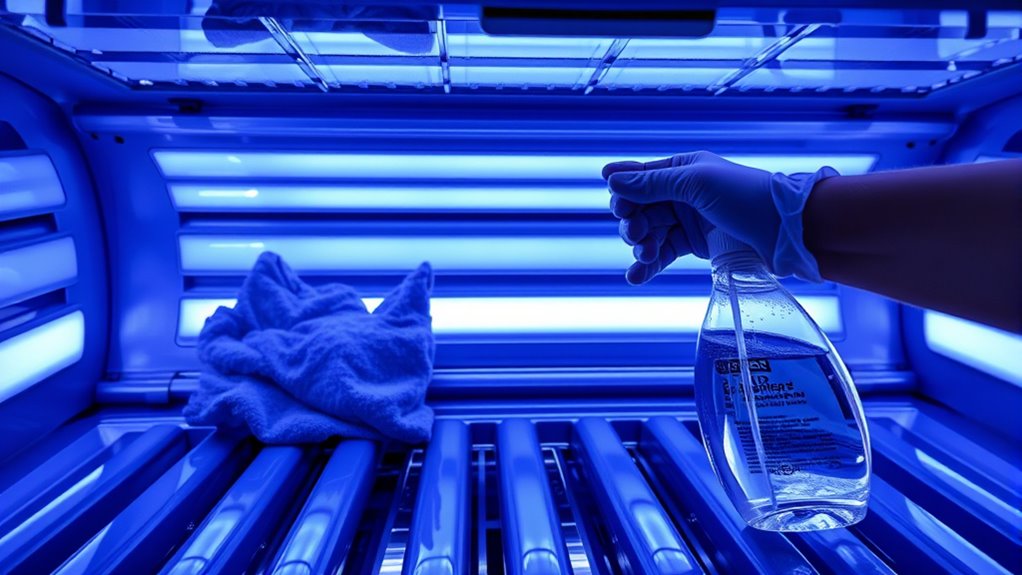
To guarantee your tanning bed remains safe and hygienic, you need to follow consistent cleaning and disinfection practices. Spray disinfectant on all surfaces, including the acrylic and head pillows, and let it sit for at least 30 to 60 seconds to ensure effective sanitization. Use only proper tanning bed disinfectants—substituting with janitorial or homemade cleaners can damage equipment and harm users. Daily, spray the bed and leave it for about 10 minutes to eliminate viruses thoroughly. Always use fresh towels for each cleaning session to prevent cross-contamination. Prepare disinfectant solutions daily, testing them with quat strips to confirm efficacy. Cover all high-touch areas, like handles, with disinfectant, maintaining a routine that keeps your bed clean, safe, and ready for every user. Incorporating disinfection protocols supported by scientific research can further enhance safety measures and reduce infection risks. Implementing proper cleaning procedures is essential to maintaining optimal hygiene standards. Proper cleaning also contributes to the longevity of your equipment, ensuring it functions optimally for years to come. Additionally, adhering to manufacturer guidelines for cleaning ensures the longevity and performance of your tanning bed. Regular maintenance, including equipment inspection, can help identify potential issues early and prevent breakdowns.
Equipment Inspection and Operation Checks

Regularly examining your tanning equipment guarantees it operates safely and effectively. Begin by inspecting acrylic shields for cracks, scratches, or cloudiness; replace damaged ones to prevent UV exposure risks. Check physical barriers like handholds and non-slip floors for stability and compliance. Ensure booth doors open outward and function smoothly for emergency exits. Keep the bed’s temperature below 100°F to meet safety guidelines. Verify that bed alignment and structural components are secure, with no loose parts. Test remote timers annually for accuracy within ±10%, confirming emergency shut-off switches are accessible and functional. Review T-Max systems to ensure automatic shutdown after maximum exposure. Document all inspections, repairs, and test results to maintain thorough records. Regular checks help prevent malfunctions and ensure safe tanning experiences. Additionally, conducting equipment maintenance regularly can extend the lifespan of your tanning bed and improve performance. Staying informed about safety standards can further help you maintain compliance and ensure user safety. Incorporating routine cleaning of internal components can also prevent dust buildup and mechanical issues. Furthermore, monitoring operational parameters ensures consistent performance and safety during each use. Consulting with a qualified technician periodically can help identify potential issues before they escalate.
Lamp and Starter Maintenance Procedures

Maintaining your tanning bed’s lamps and starters is essential for consistent performance and safety. Regularly inspect your starters, replacing them when lamps flicker, won’t light, or operate inconsistently. Use the manufacturer-recommended starters to guarantee compatibility and peak results. Keep spare starters on hand to minimize downtime. For lamps, implement a rotation system to extend their lifespan—replace them around 50-60% of their rated hours and move top lamps to bottom positions to balance wear. Clean lamps every six months with a specialized cleaner and lint-free cloth, avoiding liquids directly on the bulbs. Additionally, check and clean lamp sockets and contacts regularly to prevent electrical issues. Document all maintenance activities, including replacements and inspections, to maintain a safe and efficient tanning environment. Understanding the importance of lamps and starters can help ensure your equipment performs optimally and lasts longer.
Acrylic Shield Care and Damage Prevention
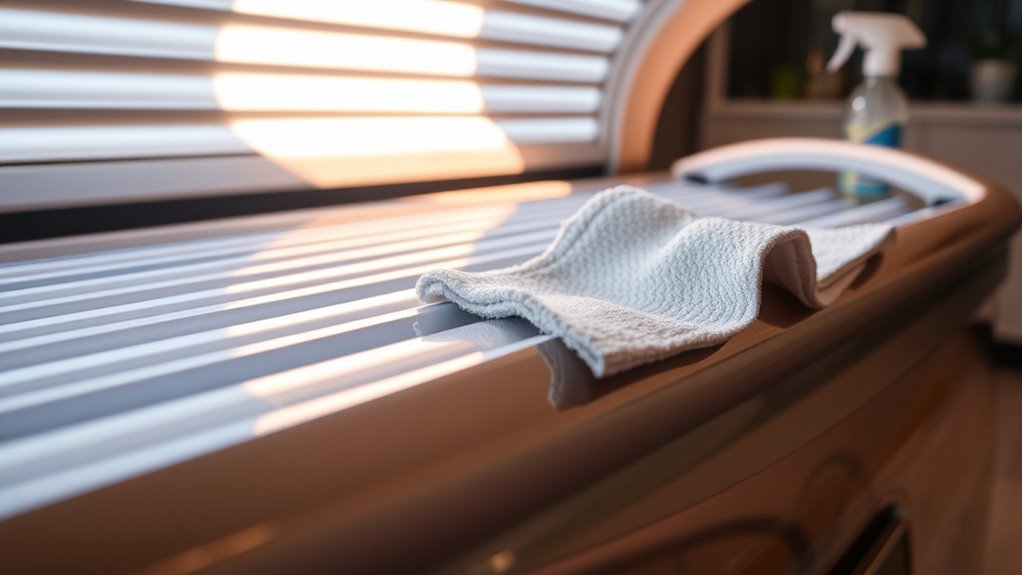
Ensuring your acrylic shields stay clear and intact is essential for peak tanning performance and client safety. Regularly clean both sides of the shields after each session with approved acrylic cleaners, avoiding alcohol or ammonia-based products that cause brittleness. Use gentle, non-abrasive tools to prevent scratches. Weekly, remove the shields for deep cleaning, inspecting for cracks, scratches, or warping. Dust reflectors and lamps during this process to maintain maximum light output. To prevent damage, request acrylic that’s “annealed” for durability and opt for thicker bottom shields to handle higher stress. Avoid harsh chemicals and handle acrylic carefully to prevent warping or discoloration. Proper maintenance practices and handling of acrylic shields is vital for extending the lifespan of your acrylic shields and ensuring consistent tanning results. Regular inspections can help identify early signs of wear, preventing costly replacements later. Promptly replace any worn or damaged shields to ensure maximum UV transmission and long-lasting performance. Proper care keeps your tanning bed safe and efficient. Additionally, choosing high-quality acrylic materials can significantly improve the durability and longevity of your shields.
Ensuring User Safety and Operational Guidelines
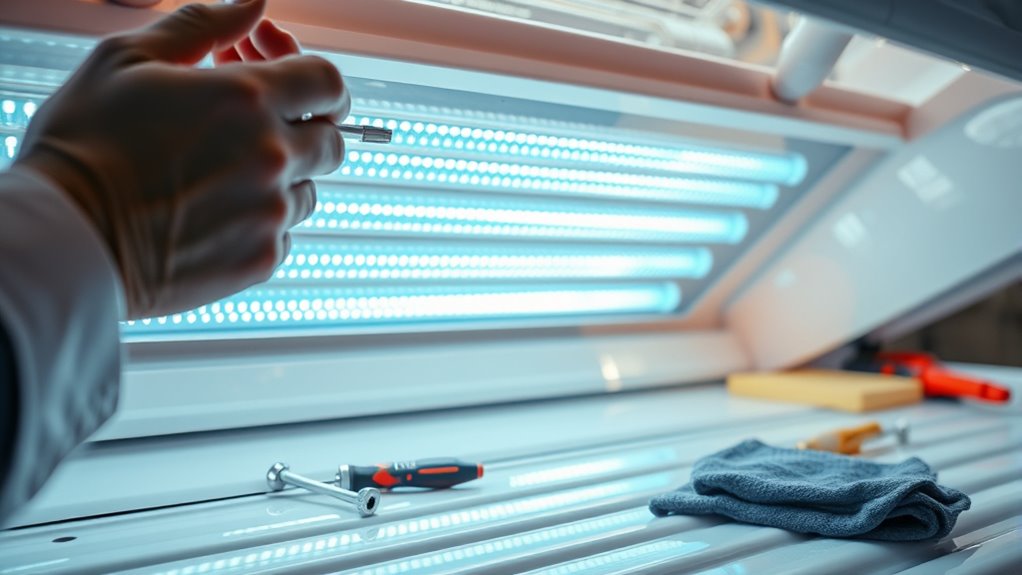
Proper maintenance of your tanning bed includes not only caring for its components but also following safety protocols to protect users. It is crucial to follow the manufacturer’s guidelines for operation, avoiding overexposure by limiting session lengths. Regularly inspect the equipment to confirm all parts are functioning correctly. Educate users about health risks like skin cancer and emphasize safe practices, such as avoiding tanning before age 35. Enforce age restrictions, provide clear health disclosures, and set maximum session limits to prevent overuse. Make certain staff are well-trained in safety procedures and regulatory compliance. Display warning signs and keep detailed records to promote a safe environment and minimize liability. Additionally, keeping up with equipment maintenance can extend the lifespan of your tanning bed and ensure consistent, safe operation. Properly managing filter replacement schedules and cleaning routines is essential to maintain optimal performance and safety standards. Incorporating proper consecration of safety measures can also reinforce a culture of responsibility. Regularly reviewing safety standards and regulations helps ensure ongoing compliance and safety excellence. Implementing a routine training program for staff can further enhance safety awareness and operational consistency.
Implementing Preventative Maintenance Scheduling
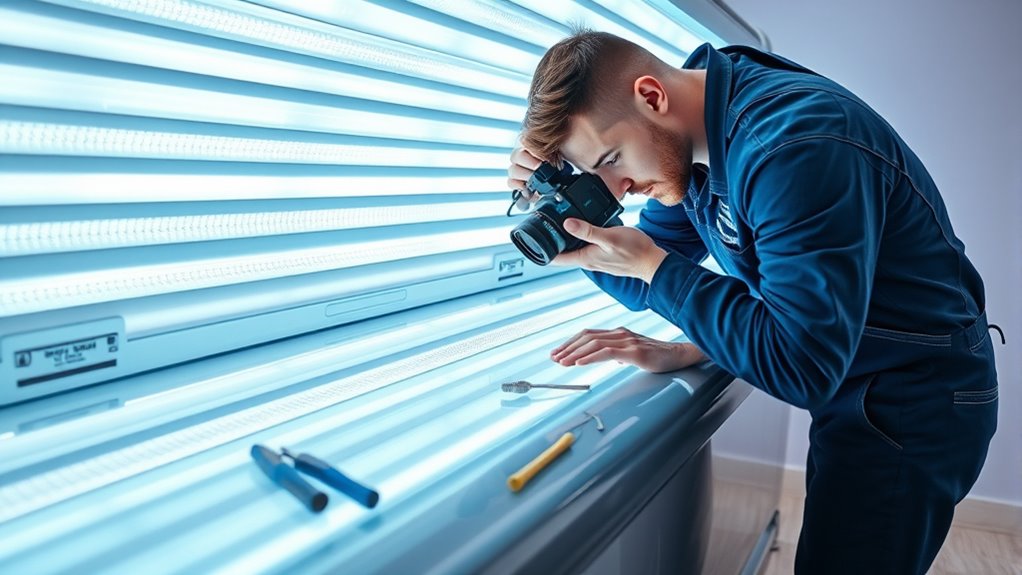
Implementing a preventative maintenance schedule is essential to keep your tanning bed operating safely and efficiently. Start by establishing daily routines, like turning on the bed to verify all lamps light properly, listening for unusual noises or odors, checking vents for dust or hair, and disinfecting contact surfaces after each use. Weekly, focus on thoroughly cleaning acrylic shields, inspecting vents, dusting internal components, and checking filters. Monthly, perform deep cleaning, inspect lamps, and verify electrical safety. Every quarter, replace lamps as needed, maintain moving parts, calibrate thermostats, and restock cleaning supplies. A consistent schedule minimizes downtime, extends equipment lifespan, and ensures safe, reliable operation. Incorporating proper equipment maintenance routines, such as inspecting wiring and connections, can prevent potential malfunctions before they occur. Additionally, monitoring for signs of lamp deterioration and addressing issues promptly can help maintain optimal performance. Regularly reviewing manufacturer guidelines for lamp replacement, cleaning procedures, and other maintenance tasks is also beneficial to ensure compliance and safety. Furthermore, documenting each maintenance activity helps track the condition of your equipment and plan future inspections. Annually, conduct a thorough inspection, seek professional servicing if necessary, replace worn parts, and consider equipment upgrades.
Frequently Asked Questions
How Often Should I Calibrate the Tanning Bed’S UV Output?
You wonder how often to calibrate your tanning bed’s UV output. Typically, you should do it every 6 to 12 months, especially if your bed is heavily used or over five years old. For safety and consistency, some regulations recommend quarterly or biannual calibrations. Regular checks before use or after maintenance help ensure peak performance and safety, reducing risks and maintaining quality results.
What Are Signs of Electrical Issues Beyond Noises and Smells?
Ever wonder how you can spot electrical issues without hearing noises or smelling burning? If lamps flicker or fail to ignite, it’s a sign of ballast trouble. Frequent circuit breaker trips, low voltage readings, or loose wiring at connections also point to electrical problems. You might notice inconsistent tanning results or delayed lamp start-ups, indicating underlying wiring or power supply issues. Stay vigilant—these signs can prevent bigger, costly repairs.
How Can I Prevent Acrylic Shield Fogging or Discoloration?
To prevent acrylic shield fogging or discoloration, you should clean the surface regularly with appropriate products to prevent residue buildup. Use acrylic-friendly lotions to avoid damage, and keep the environment stable by controlling humidity and temperature. Inspect the shields often and replace them when needed. Additionally, polishing with products like Novus Polish can restore clarity, helping your shields stay clear and effective for a longer time.
What Safety Measures Are Recommended for Staff During Maintenance?
Think of yourself as a guardian, protecting both the equipment and clients. During maintenance, you should always wear eye protection, like a shield guarding your vision. Regularly check for electrical issues, unusual smells, or noises to prevent hazards. Keep vents clear to guarantee good airflow. Follow safety protocols diligently, stay trained, and use appropriate disinfectants. These steps safeguard your health and keep the equipment running smoothly, just like a vigilant protector.
How Do I Identify When a Lamp or Starter Is Failing Early?
When you want to spot early signs of lamp or starter failure, pay attention to flickering or slow starts. If a lamp takes longer to light or flickers excessively, it’s likely nearing the end of its life. For starters, frequent flickering or failure to ignite indicates they’re worn out. Test lamps in different positions to pinpoint issues, and replace starters before they cause damage, saving you time and money.
Conclusion
Regular maintenance keeps your tanning bed safe and effective, preventing costly repairs and ensuring a great tanning experience. Did you know that improper care can reduce lamp lifespan by up to 50%? By following these upkeep tips, you’ll extend your equipment’s life and maintain peak performance. Stay consistent with cleaning, inspections, and preventative schedules—you’re investing in safety and longevity. Keep your tanning bed in top shape, and enjoy ideal results every time!



